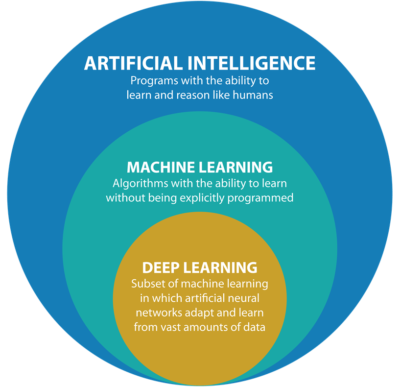
To most people, deep learning and machine learning phrases sound like the interchangeable buzzwords of the AI universe. However, that isn’t true. Anyone who wishes to better understand the field of artificial intelligence should therefore begin by understanding the terms and their distinctions.
Deep learning is a specialized subset of machine learning, which in turn is a subset of artificial intelligence, to break it down into a single sentence. In other words, deep learning is machine learning.
The general term for when machines learn from data is machine learning. It explains the convergence of computer science and statistics in which algorithms are used without being specifically programmed to perform a particular task; instead, they identify data patterns and make predictions until new data arrives.
In general, depending on the data being used to feed the algorithms, the learning process of these algorithms may either be supervised or unsupervised.
A traditional machine learning algorithm can be something as simple as linear regression.
Although this example sounds easy, it counts as machine learning and, indeed, ordinary statistics are the driving force behind machine learning. Without being specifically programmed, the algorithm learned to make a guess, only based on patterns and inference.
In summarization, Machine learning is:-
- Machine learning is at the intersection of computer science and statistics through which computers receive the ability to learn without being explicitly programmed.
- There are two broad categories of machine learning problems: supervised and unsupervised learning.
It is possible to consider deep learning algorithms as a sophisticated and mathematically complex evolution of machine learning algorithms. Lately, and with good reason, the area has attracted a lot of attention: recent discoveries have led to findings that were not considered to be possible before.
Deep learning defines algorithms that interpret data similar to how a person might draw conclusions using a logic structure. Notice that, in both supervised and unsupervised instruction, this can happen. Deep learning apps use a layered system of algorithms called an artificial neural network to do this (ANN).
Consider the example ANN in the image above. The leftmost layer is called the input layer, the rightmost layer of the output layer. The middle layers are called hidden layers because their values aren’t observable in the training set. In simple terms, hidden layers are calculated values used by the network to do its “magic”. The more hidden layers a network has between the input and output layer, the deeper it is. In general, any ANN with two or more hidden layers is referred to as a deep neural network.
In many areas, deep learning is used today. For example, deep learning is used in automated driving to detect objects, such as STOP signs or pedestrians. In order to classify objects from satellites, the military uses deep learning to discover secure or dangerous areas for its soldiers, for example. The consumer electronics industry, of course, too, is full of deep learning.
Overall, through automatic feature engineering and its self-learning capabilities, the deep learning algorithms need only little human intervention. While this shows the huge potential of deep learning, there are two main reasons why it has only recently attained so much usability: data availability and computing power.
And moreover , deep learning requires incredibly vast amounts of data and deep learning needs substantial computing power.
But probably one of the most important advances in the field of deep learning is the emergence of transfer learning, i.e. the use of pre-trained models. The reason: Transfer learning can be regarded as a cure for the needs of large training datasets that were necessary for ANNs to produce meaningful results.
Conclusion
- Deep learning is a specialized subset of machine learning.
- Deep learning relies on a layered structure of algorithms called an artificial neural network.
- Deep learning has huge data needs but requires little human intervention to function properly.
- Transfer learning is a cure for the needs of large training datasets.
The ANN algorithm structure, the lower need for human intervention, and the larger data requirements are major things which make Deep learning unique!
Thanks for reading! I write on Medium about data science-related topics, so you can follow me to get notified when I write more articles like this one.
And don’t forget to press the clap button if you liked the article 🙂
Follow me on Linkedin if you’d like to stay in touch!
